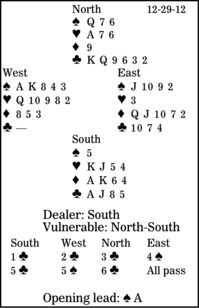Bridge column, November 29: Sound bridge advice from a new author

In this deal from the book, how should South plan the play in six clubs after West leads the spade ace and shifts to a diamond?
West's two clubs is a Michaels Cue-Bid, showing at least 5-5 in the majors. Now North should use the two cue-bids (two hearts and two spades) to indicate good hands in the other two suits, clubs and diamonds, respectively. Here, North would respond two hearts. (Then, his three clubs would be purely competitive, five-plus clubs but a weak hand.) The rest of the auction is highly debatable, especially West's five-spade bid; he described his hand on round one.
The simplest way to look at this contract is to find 12 winners, assuming that the heart finesse is failing. On top, South has two hearts, two diamonds and six clubs. The other two tricks must be spade ruffs in the shorter trump hand, resulting in a total of eight club tricks. But declarer must be careful with his dummy entries. Perhaps East is void in hearts and the defenders have erred.
After winning with his diamond ace, South should cash the club ace, play a trump to dummy's queen, ruff a spade, ruff a diamond (certain to be safe), ruff the spade queen, ruff another diamond, draw East's last trump, and claim.
** ** **
COPYRIGHT: 2012, UNITED FEATURE SYNDICATE
DISTRIBUTED BY UNIVERSAL UCLICK FOR UFS

